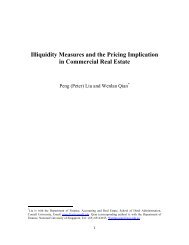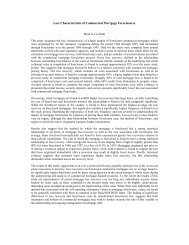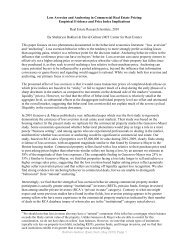Commercial Mortgage Delinquency, Foreclosure and Reinstatement
Commercial Mortgage Delinquency, Foreclosure and Reinstatement
Commercial Mortgage Delinquency, Foreclosure and Reinstatement
Create successful ePaper yourself
Turn your PDF publications into a flip-book with our unique Google optimized e-Paper software.
1 Introduction<strong>Commercial</strong> mortgages are a large asset class. The size of the U.S. market was about$1.2 trillion 1 at the end of 2000, about a quarter of the size of the market for corporate bonds. Butdespite the large size of the market, the size of the body of academic literature about commercialmortgages is small. This is most likely due to the difficulty in obtaining access to data 2 , sincemost commercial mortgages are held by the originating lender <strong>and</strong> are not traded on anysecondary market. However, as the secondary market grows through the issuance of commercialmortgage backed securities, so does the need for research that addresses questions about this assetclass 3 .<strong>Commercial</strong> mortgages have term structure risk, like corporate bonds. But while thesource of cash flow to service corporate bonds is from the general operation of the firm, thesource of cash flow for commercial mortgages is the rental income of the specific propertysecured by the mortgage. Therefore, the structure of default risk is different. This is an importantfactor that distinguishes the two asset classes. In addition, commercial mortgages are less liquid<strong>and</strong> less divisible than corporate bonds, <strong>and</strong> have a different payment structure. <strong>Commercial</strong>mortgages typically have amortizing payments of interest <strong>and</strong> principal, while corporate bondstypically have only interest coupons. In this paper, I examine how the differences in the assetclasses are manifested in the returns using multiple factor asset pricing models.The development <strong>and</strong> testing of asset pricing models is one of the central research areasin finance dating back to the 1960s with the work of Sharpe (1964) <strong>and</strong> Lintner (1965) on thecapital asset pricing model. But most of research attention is turned to stock market returns, withlittle attention to bonds <strong>and</strong> real estate, <strong>and</strong> no work at all on commercial mortgages.1 Federal Reserve Board, Flow of Funds Accounts of the United States, September 18, 2001.2 In this paper, I overcome this problem by using an index created by Giliberto-Levy Inc. Further detailsare in the data description in section 4.3 The amount of CMBS issued grew from less than $10 billion in 1990 to over $90 billion in 2001.(Source: John B. Levy, The Ground Floor, Barron’s, January 1991 <strong>and</strong> January 2001).1





